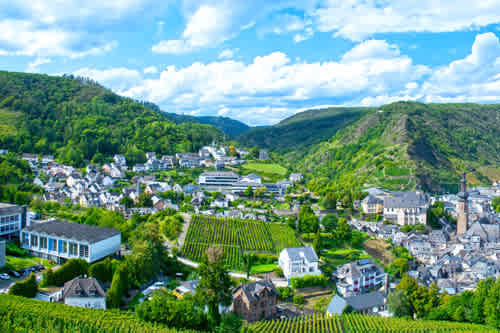History, Culture, Landscapes of rivers, lakes and forests, hiking rails and water activities and so much more. That is Koblenz!
About Koblenz
What’s the common denominator between (1) the unforgettable famous Deutsches Eck, (2) Max and (und) Moritz, (3) the little boy that spits erratically at those who walk by, (4) the quote "Mr. Inspector, write a report that the man’s dog urinated twice on my husband." If you said the city of Koblenz – then you are right! That is Koblenz – fun, interesting and beautiful and also on the list of UNESCO World Heritage site because of the riverfront area between Deutsches Eck and the Rüdesheim/Bingen. Koblenz is home to the playful, impish boys, the Ehrenbreitstein Fortress and the tongue-in cheek statue Schangelbrunnen in front of the Town Hall with the plaque “Mr. Inspector” etc.
The city of Koblenz is located at the convergence of the Rhine and Moselle rivers and at the northern mouth of the Rhine Valley, which extends to Rudesheim in the south. This is an easy starting point for exploring this beautiful and ancient city, the “German Corner” (Deutsche Eck) which is where the Moselle and Rhine rivers meet. Note: The Rhine Gorge was declared a World Heritage Site in 2002, with Koblenz marking the northern end.
Many sites in the city have a 2000-year history: buildings, fortresses, churches, mansion, homes of the rich with spacious courtyards, located in breath-taking landscapes, with flowing rivers, mountains, forests and green fields.
Erected in 1870 the giant statue of Wilhelm I, who was first German Emperor, stands proudly in the Deutsche Eck, with reliefs of the states of reunified Germany on the wall. The statue that we see now was reconstructed and re-erected in 1993 due to the fact that at the end of WWII it was destroyed.
Kodak Moment: If you climb the inner stairs to the top of the monument to the platform, you will be able to capture a unique photo of the coming together of the Moselle River and Rhine River. As well you’ll be able to get a shot of the city’s most memorable landmark, the Ehrenbreitstein Fortress, which is on the other side. It can be reached by cable car. Whilst there, do take time to enjoy the State Museum of Koblenz, which has four exhibition buildings.
Note: If you are coming by car there is a parking lot near the entrance to the building of the Ehrenbreitstein Fortress Cultural Centre.
Continuing towards the Moselle River there is a pedestrian path leading to the Ludwig Museum named for the art collectors who established this contemporary art museum in the Deutschesherrenhaus, a former bastion of the 12th century.
Continuing on your walk via the courtyard you will reach the Basilica of St. Castor (Kastorkirche) which was consecrated in 836, making it the oldest church in Koblenz. The monastery-church was named for Saint Castor of Karden who founded a religious community in Karden, when, in the fourth century, he was sent on a mission to the Moselle region. A monument-fountain (Kastorbrunnen) which was built in 1812, stands in front of the basilica, a testimony of the Napoleonic Wars, which helps us to understand the French-German lifestyle, including architectural styles and even local cuisines.
Gorresplatz Square (Josef Goress Platz) has an impressive modern 10-meter bronze history column depicting the history of the city from Roman times (at its base) to the future of the city (at its apex). A nearby sign explains the different periods during the first two thousand years.
Town Hall: On the Willi-Horter-Platz, the amusing bronze statue Schangelbrunnen stands in the courtyard surrounded by the Renaissance and Baroque buildings. This is from the period when the French ruled the city and it was popular for parents to name their children Schang (the German version of French “Jean”) named after the iconic sculpture of the little boy that spits erratically at those who walk by.
Note: When you walk through the city, look down and you’ll see the city sewer covers have a relief of the spitting child.
Another humorous statue from the 19th century which is on Munzplatz Square, depicts a woman with a basket of vegetables complaining to the inspector/policeman: The plaque reads as follows (loosely translated): "Mr. Inspector, write a report that the man’s dog urinated twice on my husband."
The outer wall of a local (presently) snack bar "Zum Eßkesselchen" is decorated with a scene from the stories of "Max and (und) Moritz" written and illustrated by Wilhelm Busch. This famous work, often referred to as the precursor of comics as we know it today, was published around 1865.
The Church of Our Beloved Lady (Liebfrauenkirche), was built on a site where it is assumed churches and cult structures were built from the 5th century. From the 15th century on it has been renovated and converted many times on the original foundations. It was also badly damaged during WWII and as a result reconstructed in in the early 1950’s. The congregation of this church is still active and is one of the oldest in Koblenz and one can hear choirs and music as well as bells coming from the church. The bells have been ringing since the beginning of the 17th century; the towers were renovated. And if you’d like to hear the bells, at 22:00 every night there is a carillon warning that the city gates are closing.
Lohstrasse is a pedestrian shopping mall, with a wide range of shops, cafes, restaurants where it is worth to ask for the local dish Rieslings Schnitte (high in calories but worth it).
Popular Itineraries
Traveled by thousands
Koblenz Hotels
by

Looking for some interesting things to do in Koblenz? Here are some recommended attractions and sights for you.
outdoor activities
tours, sightseeing & cruises
Attractions in Koblenz
- Historic Center, Koblenz







 Travel Perks
Travel Perks